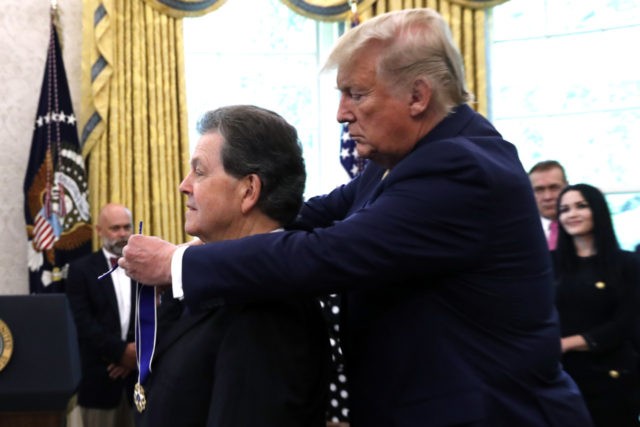President Donald Trump awarded renowned Reagan Administration economist and father of supply-side economics Art Laffer the Medal of Freedom in the Oval Office Wednesday.
“Few people in history have revolutionized economic theory like Arthur Laffer,” President Trump said. “Greater opportunity for all Americans, and he’a done it again and again.” He made reference to the stagflation of the 1970s before Laffer came on the scene, then related this to the current day. “Right now, we have inflation at almost nothing,” said the president. “We realize how well we’re doing right now.”
President Trump talked about the economy under President Ronald Reagan before turning again to the current day. “Our economy has never, ever been stronger than it is today,” said Trump. The president recalled first quarter 2019 GDP growth at “double and even triple what we expected” and heralded his administration’s work on trade deals.
“I’ve heard and studied the Laffer curve for many years,” said President Trump. “A very important thing you did, Art.”
President Trump presented Laffer with the Medal of Freedom, the highest civilian honor, in front of the Resolute Desk in the Oval Office.
Laffer served on President Reagan’s Economic Policy Advisory Board. He has also been a consultant to both the Department of Treasury and the Department of Defense. Laffer worked with fellow economist Stephen Moore on 2016 candidate Donald Trump’s job creation platform.
“Arthur B. Laffer, the “Father of Supply-Side Economics,” is one of the most influential economists in American history,” Press Secretary Sarah Sanders said in a statement announcing the president would present the award to Laffer. “He is renowned for his economic theory, the “Laffer Curve,” which establishes the strong incentive effects of lower tax rates that spur investment, production, jobs, wages, economic growth, and tax compliance.”
The “Laffer Curve” was essentially born during a dinner in 1974. Laffer was dining in Washington, DC, with advisers to President Gerald Ford Donald Rumsfeld and Dick Cheney, and writer for the Wall Street Journal Jude Wanniski. In order to illustrate the relationship between tax rates and tax revenue, Laffer drew a graph on a napkin. The image depicted the point at which tax revenue is maximized and the point at which increasing tax rates would lead to decreasing tax revenue.
Similar concepts illustrated in the curve had been around before, but Laffer’s depiction and Wanniski’s writings on what was dubbed the “Laffer Curve,” popularized the economic principle.
White House National Economic Council Director Larry Kudlow has praised Laffer as “huge influence on my thinking,” as NPR quoted him saying last week. “I know some people agree and some people may not agree with his views. But I’m a Laffer Curve guy.” Kudlow discusses Laffer’s work and history in his book JFK and the Reagan Revolution.
Kudlow remarked in 2017 on CNBC that Laffer “should have won a Nobel prize” for the Laffer Curve.
Laffer joined with Moore to pen the book Trumponomics, a look into what the book subtitle calls, “the America First Plan to Revive Our Economy.” Kudlow wrote the forward for the work that was released in 2018.
A list of those expected to be in attendance as President Trump presented Laffer with the award were Treasury Sec. Steve Mnuchin, Labor Sec. Alex Acosta, Department of Housing and Urban Development Sec. Ben Carson, Transportation Sec. Elaine Chao, NEC Director Kudlow, Council of Economic Advisers Chairman Kevin Hassett, and Kudlow’s Chief of Staff Susan Varga. Moore was also on a list of expected attendees. Vice President Mike Pence was spotted at the ceremony standing next to Kudlow.
Michelle Moons is a White House Correspondent for Breitbart News — follow on Twitter @MichelleDiana and Facebook

COMMENTS
Please let us know if you're having issues with commenting.